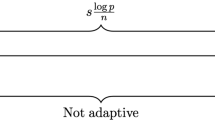Abstract
Mulreg is an interactive computing environment for data exploration, regression modeling, and the visualization and use of regression results. It is designed to allow both statisticians and nonstatisticians easy access to state-of-the-art tools for linear modeling. Design features of Mulreg are the object orientation of its internal data structures and of its user interface, its integration of graphics into every stage of the modeling process, the guidance provided by the menu layout, and the choice of statistical algorithms, which provide a consistent data analysis strategy to attack the great diversity of regression-type problems.
Similar content being viewed by others
Explore related subjects
Discover the latest articles, news and stories from top researchers in related subjects.References
W. DuMouchel, RS/Explore, the electronic data analysis advisor, Chance 1, no. 4 (Fall 1988) 12–23.
RS/Explore Mulreg Reference Manual (BBN Software Products Corporation, Cambridge, 1988).
RS/Explore Primer (BBN Software Products Corporation, Cambridge, 1988).
RS/Explore Statistical Appendices (BBN Software Products Corporation, Cambridge, 1988).
J.D. Emerson and M.A. Stoto, M.A. transforming data, in:Understanding Robust and Exploratory Data Analysis, eds. D. Hoaglin, F. Mosteller and J. Tukey (Wiley, New York, 1983).
G.E.P. Box, W.G. Hunter and J.S. Hunter,Statistics for Experimenters (Wiley, New York, 1978).
B.J. Winer,Statistical Principles in Experimental Design, 2nd ed. (McGraw-Hill, New York, 1971) sect. 10.6.
W. DuMouchel, Graphical representation of main effects and interaction effects in a polynomial regression on several predictors, in:Proc. 20th Symp. on the Interface: Computer Science and Statistics, George Mason University (1988).
C.L. Mallows, Augmented partial residuals, Technometrics 28 (1986) 313.
B. Streitberg, On the nonexistence of expert systems — critical remarks on artificial intelligence in statistics (with discussion), Statistical Software Newsletter 14 (1988) 55.
Author information
Authors and Affiliations
Rights and permissions
About this article
Cite this article
DuMouchel, W. The structure, design principles, and strategies of Mulreg. Ann Math Artif Intell 2, 117–134 (1990). https://doi.org/10.1007/BF01531001
Issue Date:
DOI: https://doi.org/10.1007/BF01531001




